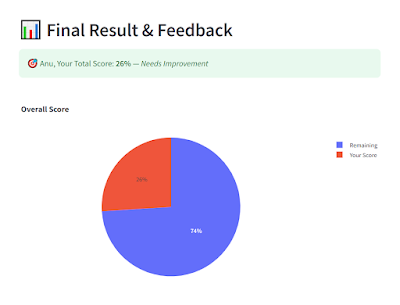Aptitude Test Web App using Streamlit and LLMs
🧠 Introduction
In today's competitive environment, assessing aptitude and reasoning skills has become essential for job placements and government exams. To address this, our team developed an Aptitude Test Web App using Python, Streamlit, and LLM (Groq’s LLaMA-3). The application dynamically generates multiple-choice questions across three core sections: Quantitative, Logical, and Verbal, simulating a real exam experience.
💻 Tech Stack
-
Frontend & App: Streamlit
-
Backend AI Model: LLaMA-3 via Groq API
-
Data Visualization: Plotly
-
Language: Python
🎯 Objective
To build a dynamic aptitude test platform that:
-
Generates section-wise questions of varying difficulty using an LLM.
-
Tracks user performance in real-time.
-
Displays section-wise scores and feedback after the test.
🧪 Test Structure
-
Total Questions: 45
-
Sections: Quantitative, Logical, Verbal
-
Each Section: 15 questions (5 Easy, 5 Medium, 5 Hard)
-
Time: 1 min per question
-
Scoring: +1 per correct answer, no negative marking
🛠️ Features
-
User Input Page – Name, email, and phone number.
-
LLM-based Question Generator – Uses Groq's LLaMA-3 to generate MCQs from real exam topics like SSC, CAT, GATE, etc.
-
Timer per Question – 60-second timer per question.
-
Dynamic Section Loading – Each section starts with instructions and then loads questions.
-
Live Answer Tracking – Saves responses section-wise.
-
Final Result Page – Shows:
-
Overall score and rating (Excellent, Good, Average, Needs Improvement)
-
Section-wise performance
-
Plotly Pie & Bar Charts
-
Personalized feedback
-
📊 Data Visualization
-
Pie Chart: Shows overall score
-
Bar Graph: Section-wise accuracy
-
Data Table: Displays correct answers per section and overall accuracy
🤖 AI-Generated Questions
All questions are generated live using this LLaMA-3 prompt:
“Generate 15 multiple-choice questions of varying difficulty for [section] covering topics like Profit & Loss, Coding-Decoding, Grammar, etc.”
Each question includes:
-
Question text
-
4 answer options
-
Correct answer for scoring
💬 Personalized Feedback
After the test, users receive motivational and section-wise feedback:
-
Above 80%: Excellent – Practice advanced sets
-
60–79%: Good – Strengthen concepts
-
40–59%: Average – Focus on basics
-
Below 40%: Needs Improvement – Start with foundations
📷 Screenshots of the App
Before each test section begins, the app displays a brief overview of what topics are covered and how the section is structured. For example:
-
Quantitative Aptitude includes Profit & Loss, Time & Work, Percentages, etc.
-
Logical Reasoning covers Number Series, Puzzles, Blood Relations, and more
Verbal Ability focuses on Reading Comprehension, Grammar, Vocabulary, etc.
During the test, each section presents one question at a time with a 60-second countdown timer. The question includes:
-
A multiple-choice format with 4 options
-
A "Next" button to proceed (automatically moves if time runs out)
This team project helped us explore real-time UI development using Streamlit, integrate LLMs (LLaMA-3 via Groq) for dynamic question generation, and apply Plotly for data visualization. It demonstrates how AI and app development can be combined effectively in EdTech to create interactive learning tools.








Comments
Post a Comment